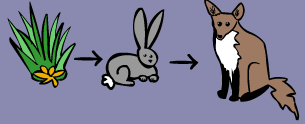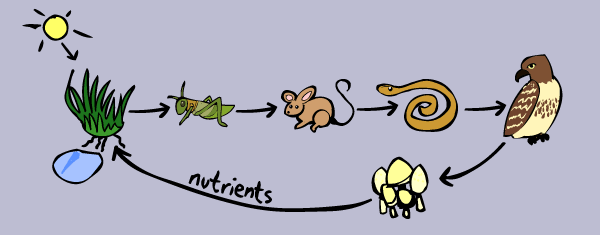The Food Chain
Every living thing needs energy in order to live. Everytime animals do something (run, jump) they use energy to do so.
Animals get energy from the food they eat, and all living things get energy from food. Plants use sunlight, water and nutrients to get energy (in a process called photosynthesis). Energy is necessary for living beings to grow.
A food chain shows how each living thing gets food, and how nutrients and energy are passed from creature to creature. Food chains begin with plant-life, and end with animal-life. Some animals eat plants, some animals eat other animals.

A food chain shows how each living organism gets its food. It shows who is eating who. A food chain only follows one path as animals find food. Remember that a food chain also includes the sun.
Food

 Webs
Webs
![]() A food web is made of several food chains connected together. A food web shows the many different paths plants and animals are connected.
A food web is made of several food chains connected together. A food web shows the many different paths plants and animals are connected.

There is actually even more to this chain. After a hawk dies, fungi (like mushrooms) and other decomposers break down the dead hawk, and turn the remains of the hawk into nutrients, which are released into the soil. The nutrients (plus sun and water) then cause the grass to grow.
It's a full circle of life and energy!!

So food chains make a full circle, and energy is passed from plant to animal to animal to decomposer and back to plant! There can be many links in food chains but not TOO many. If there are too many links, then the animal at the evnd would not get enough energy.
 |
HERBIVORES eat only plants or plant products. That makes them PRIMARY CONSUMERS. |
 |
||
|
|
CARNIVORES only eat meat! They eat other animals. That makes them SECONDARY OR TERTIARY CONSUMERS. |
 |
||
 |
OMNIVORES eat both plants and meat. So when a squirrel eats acorns or fruits, it is a PRIMARY CONSUMER; but, when it eats insects or baby birds, it is a SECONDARY CONSUMER. |
|
||
 |
DECOMPOSERS are the cleanup crew of life. They're just carnivores and herbivores that like their food already dead. Like maggots, bacteria, fungus, earthworms and other scavengers. |
Click on the link to see different animals and their food chains: http://www.tburg.k12.ny.us/mcdonald/foodch.htm